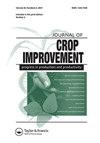干旱和温度限制对蚕豆(Vicia faba L.)发育和生长的影响
IF 1.5
Q3 AGRONOMY
引用次数: 4
摘要
蚕豆是亚洲和地中海地区重要的传统豆类作物。然而,缺水和温度这两个与气候变化相关的关键变量可能会对蚕豆的发育和生长产生重大负面影响。通过一系列实验研究了温度和水分亏缺对蚕豆基因型几个生理过程的潜在影响。节点数量的发展取决于温度,并且发现基因型之间基本恒定,每个节点出现所需的累积温度值为56°C。植物叶面积在作物碳积累中起着重要作用,通过建立植物叶面积和节数之间的异速关系来估计植物叶面积。这些关系的系数因基因型而异。水分亏缺是影响植物蒸腾和固氮速率的关键因素。在12个基因型中,蒸腾速率随土壤干燥而降低的阈值范围为0.22至0.60,表明这是提高抗旱性的遗传资源。比较不同基因型在干燥土壤上共生固氮的结果也表明了遗传变异,其中一个基因型(WW4403/H)特别耐旱。这些实验的结果确定了特定生理过程对温度和缺水敏感性的重要基因型差异,可以利用这些差异来提高蚕豆对这些环境变量的抵抗力。本文章由计算机程序翻译,如有差异,请以英文原文为准。
Impact of drought and temperature constraints on development and growth of faba bean (Vicia faba L.)
ABSTRACT Faba bean (Vicia faba L.) is an important traditional pulse crop in many parts of Asia and the Mediterranean region. However, water deficit and temperature, two of the key variables associated with climate variability, can have major negative influences on the development and growth of faba bean. A series of experiments were conducted to study the potential impact of temperature and water deficit on several physiological processes among faba bean genotypes. Development of node number was determined to be dependent on temperature and was found to be essentially constant among genotypes with a value of 56°C accumulated temperature required for appearance of each node. Plant leaf area, which is important in crop carbon accumulation, was estimated by developing allometric relationships between plant leaf area and number of nodes. The coefficients of these relationships varied among genotypes. Water deficit was found to be critical in impacting plant transpiration and nitrogen fixation rates. The threshold for the decrease in transpiration rate with soil drying was found to range from a fraction of transpirable soil water (FTSW) from 0.22 to 0.60 among 12 genotypes, indicating a genetic resource for improving drought resilience. Results in comparing symbiotic nitrogen fixation on drying soil among genotypes also indicated genetic variation, with one genotype (WW4403/H) being especially drought tolerant. The results of these experiments identified important genotypic differences in sensitivity of specific physiological processes to temperature and water deficit, which can be exploited to improve faba bean resilience to these environmental variables.
求助全文
通过发布文献求助,成功后即可免费获取论文全文。
去求助
来源期刊

Journal of Crop Improvement
Multiple-
CiteScore
3.30
自引率
7.70%
发文量
42
期刊介绍:
Journal of Crop Science and Biotechnology (JCSB) is a peer-reviewed international journal published four times a year. JCSB publishes novel and advanced original research articles on topics related to the production science of field crops and resource plants, including cropping systems, sustainable agriculture, environmental change, post-harvest management, biodiversity, crop improvement, and recent advances in physiology and molecular biology. Also covered are related subjects in a wide range of sciences such as the ecological and physiological aspects of crop production and genetic, breeding, and biotechnological approaches for crop improvement.
 求助内容:
求助内容: 应助结果提醒方式:
应助结果提醒方式:


